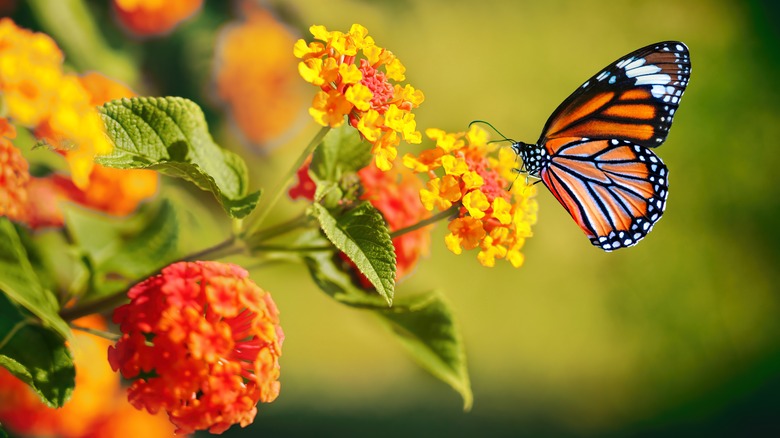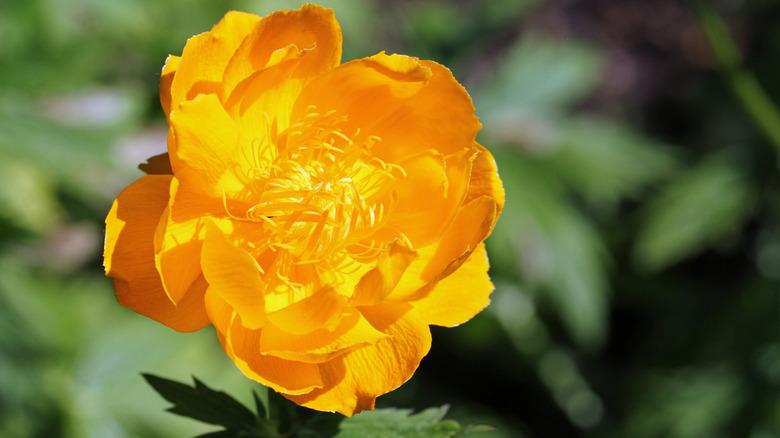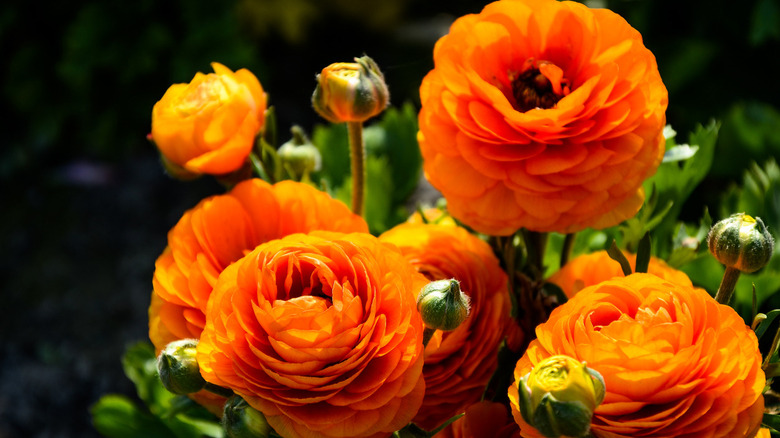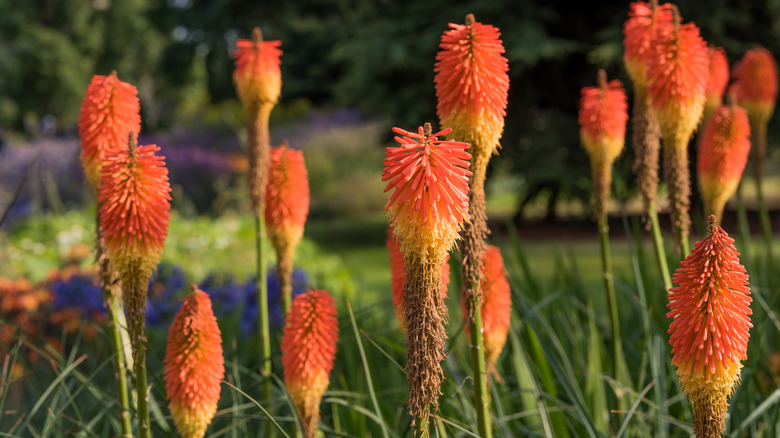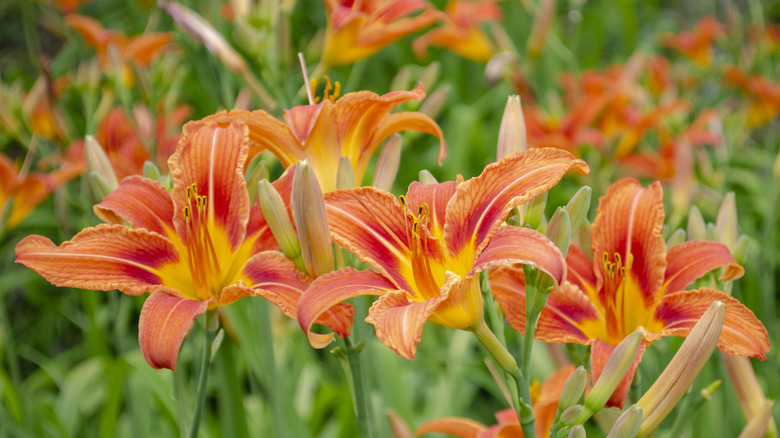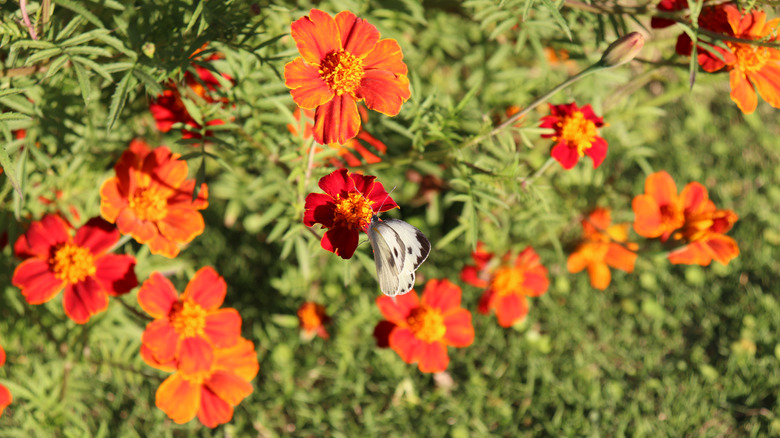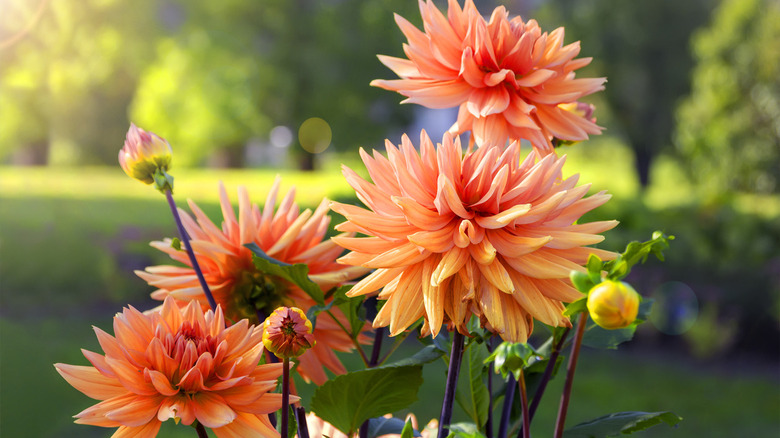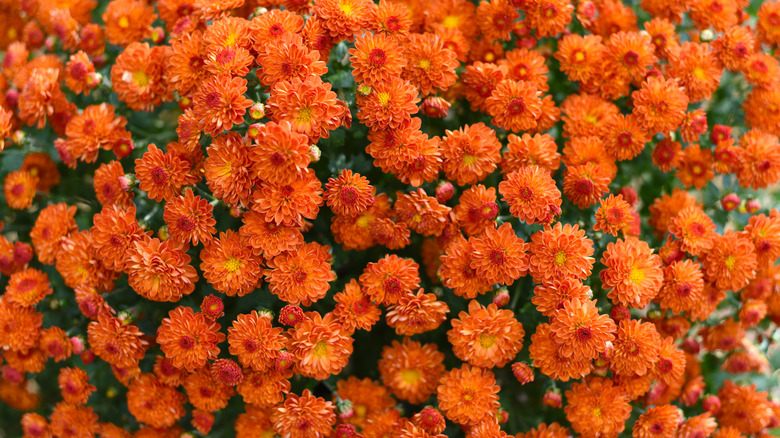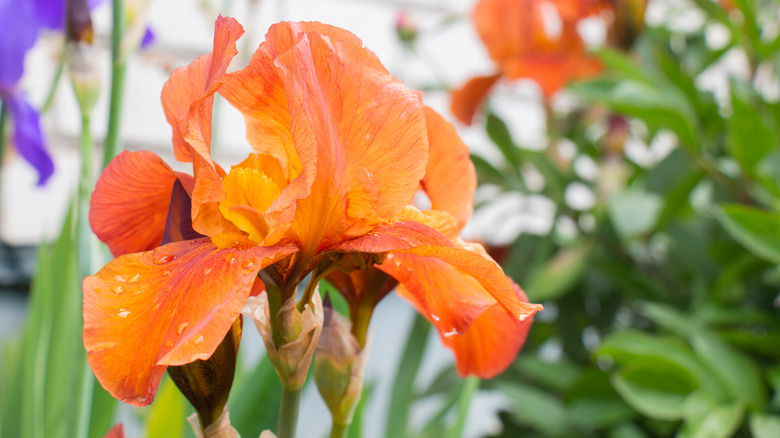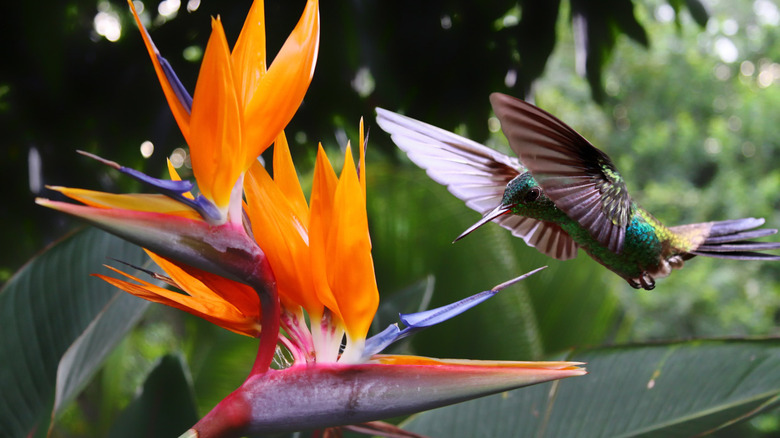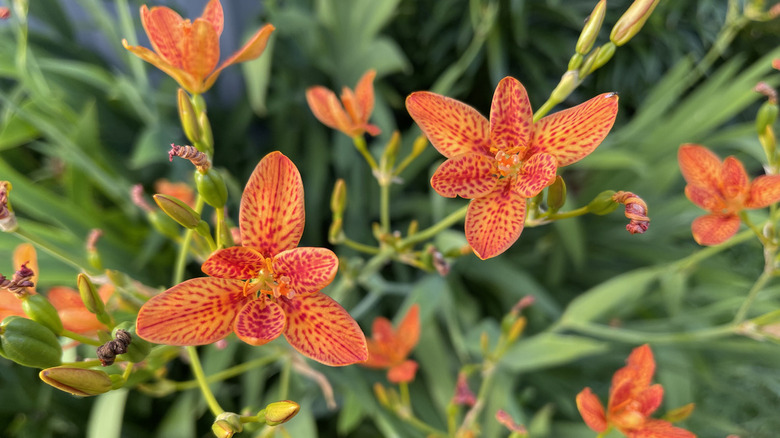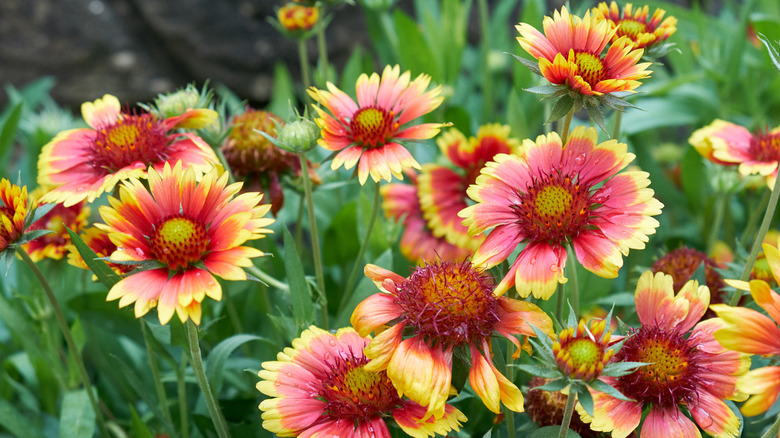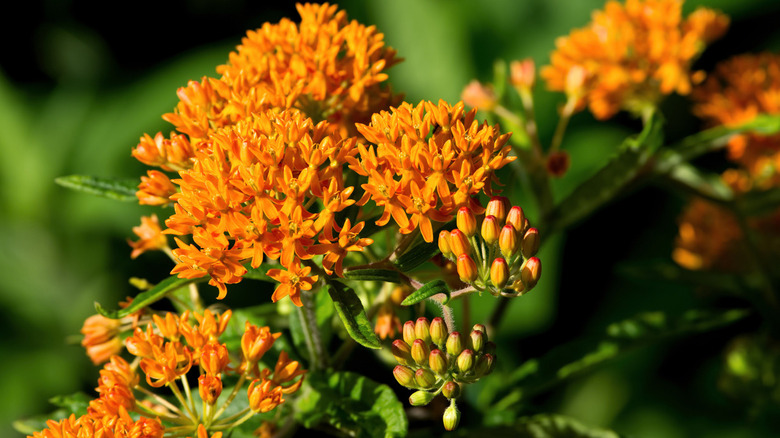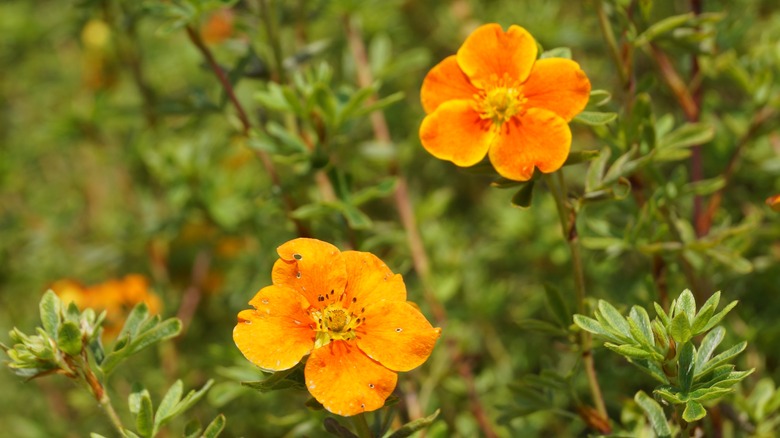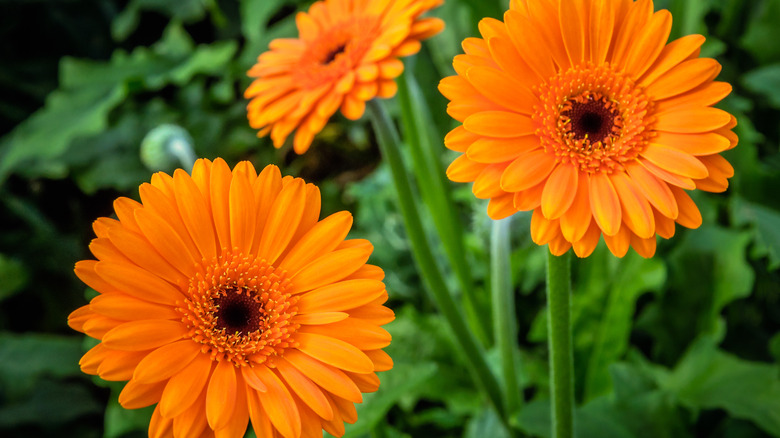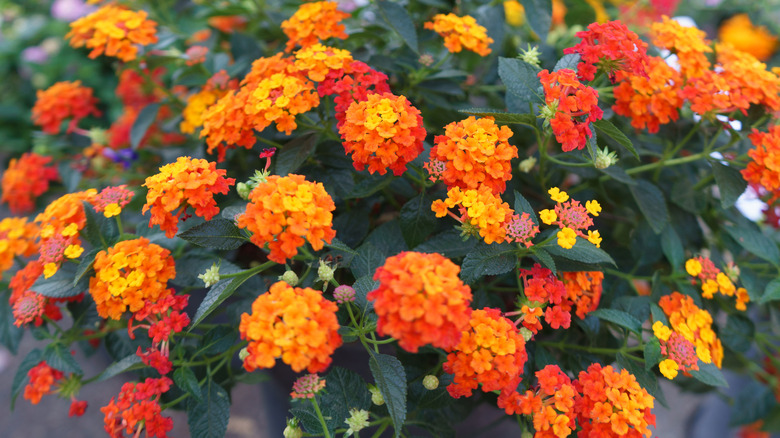15 Perennials That Bloom With Pretty Orange Flowers
If you want to add visual interest to your garden, what better way than to include plants that bloom with orange flowers? The beauty of having such varieties is that they will always come back year after year, gracing your garden with beautiful brightly-hued beauties. However, while orange is a nice vivid shade to add to your garden, you need to be aware that it can easily overpower other flower colors' appeal. In this respect, you must be careful about introducing varieties that bloom in this hue to a garden with other flowers.
The best approach is to plant them sparingly around your backyard. Orange-hued cultivars should be scattered to bring a color balance to the garden instead of planting them in large groups. Nonetheless, this is a special color that you shouldn't miss in your garden. It is associated with happiness and vitality and is likely to bring up your spirits (via Colors Explained). Look at the following orange flowers you should consider adding to your plant collection this season.
1. Globe flower
The beautiful orange blooms of the globeflower (Trollius x cultorum) will bring the wow factor to your garden from late spring to early summer. These beautiful blooms emerge from thick green foliage on top of tall stocks, thrive in damp environments, and will make an excellent addition to a rock garden, mentions North Carolina State University Extension. Additionally, they are generally low maintenance, perfect for new plant parents.
Bloom Season: Late spring to summer
USDA Growing Zone: 3-8
Growing Conditions: Full to partial sun
Soil Type: Poorly draining, moist soil
Size: 2-3 feet tall and 1-2 feet wide
2. Persian buttercup
The Persian buttercups (Ranunculus asiaticus) are an excellent choice for your garden thanks to the beautiful blooms that also make great cut flowers. It features poppy-shaped flowers with ruffled petals that are available in several colors, including orange (via Missouri Botanical Garden). They grow from tubers and relatively mature faster, giving you colorful flowers towards the end of spring or early summer.
Bloom Season: Late spring to summer
USDA Growing Zone: 8-11
Growing Conditions: Full sun
Soil Type: Well-draining sandy soil
Size: 1-2 feet tall and 1-2 feet wide
3. Torch lily
Torch lily (Kniphofia) is a popular plant known for its showy orange spike blooms that look like a flaming torch. The tall spikes rise high above the foliage on long stalks displaying their beautiful bright color. They love growing in the sun, preferably in well-draining soils, mentions North Carolina State University Extension. The flowers often change colors as the plant matures, and it is common for them to have a bicolor appearance.
Bloom Season: Spring to summer
USDA Growing Zone: 5-9
Growing Conditions: Full sun
Soil Type: Well-draining soil
Size: 3-4 feet tall and 2-3 feet wide
4. Daylily
The daylily (Hemerocallis spp.) is another plant option that comes in various colors, like yellow and orange. This variety produces flowers that typically last a day, but since each plant has several flower bulbs, you will enjoy the beautiful display for a couple of weeks. The daylily thrives in the sun, and the University of Minnesota Extension recommends at least six hours of direct sunlight daily.
Bloom Season: Spring to summer
USDA Growing Zone: 3-10
Growing Conditions: Full sun
Soil Type: Tolerates every type of soil
Size: 6 inches-5 feet tall and 2-4 feet wide
5. Rock rose
The beautiful range of rose-like flowers of the rock rose (Helianthemum) plant is what catches the eyes of most gardeners. These flowers are available in several color options, including yellow and orange, and bloom abundantly for a very long time. This low-growing shrub with evergreen foliage is ideal for rock gardens or as a border plant (via Cornell University).
Bloom Season: Spring to summer
USDA Growing Zone: 6-8
Growing Conditions: Full sun
Soil Type: Well-draining soil
Size: 6 inches-1 foot tall and 2-3 feet wide
6. Dahlia
The dahlia (Dahlia spp.) is a delightful plant that produces magnificent rounded blooms of different colors and varieties. While there are plenty of varieties, most dahlias typically grow long, and their beautiful flowers can be seen from afar. However, you should know that they are quite needy and might need extra care to grow well (via the University of Georgia Extension).
Bloom Season: Summer, fall
USDA Growing Zone: Grown as annuals in zones lower than 8
Growing Conditions: Full sun
Soil Type: Well-draining soil
Size: 1-6 feet tall and 1-3 feet wide
7. Chrysanthemum
The chrysanthemum plant is surely a delight when it blooms fully. This beautiful cultivar is available in plenty of color options, including shades of orange. The chrysanthemum is often planted in masses or small clusters, whether in the garden or indoors. While the flowers may appear dainty, you will be surprised to know that this plant is relatively easy to grow and even thrives on minimal neglect, per UtahState University.
Bloom Season: Late summer, fall
USDA Growing Zone: 3-9
Growing Conditions: Full sun
Soil Type: Rich, moist soil
Size: 2-3 feet tall and 1-3 feet wide
8. German bearded iris
The German bearded iris (Iris x germanica) is one of the prettiest varieties in the Iris family. This plant deserves a space in your outdoor garden because its flowers are not only beautiful but also produce a nice fragrance. This perennial is not only long-lived but also relatively easy to grow and care for, per Illinois Wildflowers. You can easily get new plants by dividing the grown iris right after blooming.
Bloom Season: Late spring, summer
USDA Growing Zone: 3-10
Growing Conditions: Full sun
Soil Type: Moist, well-draining soil
Size: 2-3 feet tall and 1-2 feet wide
9. Bird of paradise
The bird of paradise (Strelitzia reginae) is a beautiful plant that blooms in orange flowers that appear like the actual bird of paradise. While it can be grown right in the garden, it is also popular as a houseplant. The species' foliage grows rapidly and should be removed periodically to maintain a clean and aesthetic appearance, notes the University of Wisconsin-Madison Division of Extension.
Bloom Season: Late winter, spring
USDA Growing Zone: 10-12
Growing Conditions: Full to partial sun
Soil Type: Slightly acidic, loamy soil
Size: 20-30 feet tall
10. Blackberry lily
The blackberry lily (Iris domestica), also referred to as the leopard lily, is a short-lived perennial loved for its orange flowers with red freckles. Unfortunately, the flowers are short-lived and typically blown away by the wind after blooming. However, according to the University of Wisconsin-Madison Division of Extension, deadheading can help lengthen the flowering period and prevents self-seeding.
Bloom Season: Summer
USDA Growing Zone: 5-10
Growing Conditions: Full sun
Soil Type: Well-draining soil
Size: 2–3 feet tall, 9–24 inches wide
11. Blanket flower
If you love daisy-like blooms, then the blanket flower (Gaillardia pulchella) will be a good option for you. This plant grows relatively slowly and spreads over an area, hence its name. The blanket flower will only bloom from the second year of planting, but it will also attract different insects for a truly animated garden and find use in containers or as cut flowers via the North Carolina State University Extension.
Bloom Season: Summer, fall
USDA Growing Zone: 3-10
Growing Conditions: Full sun
Soil Type: Well-draining soil
Size: 24-36 inches tall and 12-24 inches wide
12. Butterfly weed
True to its name, the butterfly weed (Asclepias tuberosa L.) attracts butterflies to your landscape for that extra charm. It grows fairly slowly and might take up to three years before it starts blooming. However, once established, this plant will grace your garden with orange flowers that grow in clusters. The butterfly weed loves dry, well-draining soil and does well when planted under direct sun with minimal shade (via Michigan State University).
Bloom Season: Summer
USDA Growing Zone: 3-9
Growing Conditions: Full sun
Soil Type: Dry, medium soil
Size: 2-3 feet tall and 12-18 inches wide
13. Shrubby cinquefoil
If you are looking for a perennial flower that blooms for longer, consider the shrubby cinquefoil (Potentilla fruticosa). This shrub puts on a spectacular show of small yellow or orange flowers designed to impress. This plant doesn't require a lot of care, making it ideal for new plant parents or even children. The shrubby cinquefoil thrives under shade, is also winter hardy, and tolerates cold temperatures (via UtahState University Extension).
Bloom Season: Spring to summer
USDA Growing Zone: 3-7
Growing Conditions: Full sun
Soil Type: Well-draining soil
Size: 2-4 feet tall and 3-5 feet wide
14. Gerbera daisy
The gerbera daisy (Gerbera jamesonii) will definitely make you fall in love with daisy varieties. This tender perennial produces colorful flowers ranging from yellow, orange, and red, just to mention a few. The flowers rise majestically from the foliage exposing the showy blooms on long stalks. While the gerbera daisy might be a perennial, most gardeners treat it as an annual plant, especially in colder climates (via Clemson University Cooperative Extension).
Bloom Season: Spring fall
USDA Growing Zone: 8-10
Growing Conditions: Full to partial sun
Soil Type: Moist, well-draining soil
Size: 10-18 inches tall and 9-12 inches wide
15. Lantana
The lantana (Lantana camara) is a perennial climbing plant that is ideal for hanging baskets or as a ground covering. It is popular for producing small brightly colored flowers that are available in different colors, including orange, lavender, red, and yellow. This plant typically grows faster and spreads fairly quickly; therefore, you ought to be careful of where you choose to set it up (via North Carolina State University Extension).
Bloom Season: Continuously in warm climates
USDA Growing Zone: 7a-11a
Growing Conditions: Full sun
Soil Type: Well-draining soil
Size: 6 feet tall and 6 feet wide
